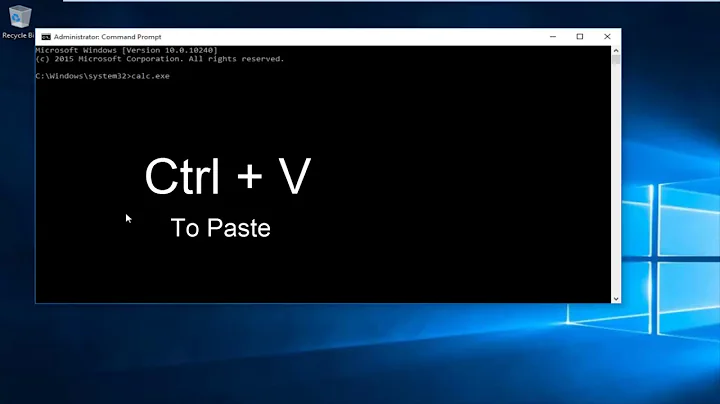A better paste command
Solution 1
Assuming you don't have any tab characters in your files,
paste file1 file2 | expand -t 13
with the arg to -t suitably chosen to cover the desired max line width in file1.
OP has added a more flexible solution:
I did this so it works without the magic number 13:
paste file1 file2 | expand -t $(( $(wc -L <file1) + 2 ))
It's not easy to type but can be used in a script.
Solution 2
I thought awk might do it nicely, so I googled "awk reading input from two files" and found an article on stackoverflow to use as a starting point.
First is the condensed version, then fully commented below that. This took a more than a few minutes to work out. I'd be glad of some refinements from smarter folks.
awk '{if(length($0)>max)max=length($0)}
FNR==NR{s1[FNR]=$0;next}{s2[FNR]=$0}
END { format = "%-" max "s\t%-" max "s\n";
numlines=(NR-FNR)>FNR?NR-FNR:FNR;
for (i=1; i<=numlines; i++) { printf format, s1[i]?s1[i]:"", s2[i]?s2[i]:"" }
}' file1 file2
And here is the fully documented version of the above.
# 2013-11-05 [email protected]
# Invoke thus:
# awk -f this_file file1 file2
# The result is what you asked for and the columns will be
# determined by input file order.
#----------------------------------------------------------
# No matter which file we're reading,
# keep track of max line length for use
# in the printf format.
#
{ if ( length($0) > max ) max=length($0) }
# FNR is record number in current file
# NR is record number over all
# while they are equal, we're reading the first file
# and we load the strings into array "s1"
# and then go to the "next" line in the file we're reading.
FNR==NR { s1[FNR]=$0; next }
# and when they aren't, we're reading the
# second file and we put the strings into
# array s2
{s2[FNR]=$0}
# At the end, after all lines from both files have
# been read,
END {
# use the max line length to create a printf format
# the right widths
format = "%-" max "s\t%-" max "s\n"
# and figure the number of array elements we need
# to cycle through in a for loop.
numlines=(NR-FNR)>FNR?NR-FNR:FNR;
for (i=1; i<=numlines; i++) {
printf format, s1[i]?s1[i]:"", s2[i]?s2[i]:""
}
}
Solution 3
On Debian and derivatives, column has a -n nomerge option that allows column to do the right thing with empty fields. Internally, column uses the wcstok(wcs, delim, ptr) function, which splits a wide character string into tokens delimited by the wide characters in the delim argument.
wcstok starts by skipping wide characters in delim, before recognizing the token. The -n option uses an algorythm that doesn't skip initial wide-characters in delim.
Unfortunately, this isn't very portable: -n is Debian-specific, and column is not in POSIX, it's apparently a BSD thing.
Solution 4
Taking out the dots that you used for padding:
file1:
ETIAM
SED
MAECENAS
DONEC
SUSPENDISSE
file2:
Lorem
Proin
Nunc
Quisque
Aenean
Nam
Vivamus
Curabitur
Nullam
Try this:
$ ( echo ".TS"; echo "l l."; paste file1 file2; echo ".TE" ) | tbl | nroff | more
And you will get:
ETIAM Lorem
SED Proin
MAECENAS Nunc
DONEC Quisque
SUSPENDISSE Aenean
Nam
Vivamus
Curabitur
Nullam
Solution 5
Not a very good solution but I was able to do it using
paste file1 file2 | sed 's/^TAB/&&/'
where TAB is replaced with the tab character.
Related videos on Youtube
Tulains Córdova
I seek not to know all the answers, but to understand the questions. - Kwai Chang Caine I've been programming for more than two decades. I specialize in database design, SQL, PL/SQL, Unix Shell Scripting, Java SE, OOP, OOD, good practices, SOLID principles, software patterns and code quality. Manipulating and processing data with scores of different tools is something I do often. I've done extensive work automating routinary tasks by leveraging Shell Scripting. I like to improve software usability and user experience. Fledgling DBA with 6 years of experience but with an awful lot to learn. Spanish is my mother tongue and I'm fluent in english. I can read technical french.
Updated on September 18, 2022Comments
-
 Tulains Córdova over 1 year
Tulains Córdova over 1 yearI have the following two files ( I padded the lines with dots so every line in a file is the same width and made file1 all caps to make it more clear).
contents of file1: ETIAM...... SED........ MAECENAS... DONEC...... SUSPENDISSE contents of file2 Lorem.... Proin.... Nunc..... Quisque.. Aenean... Nam...... Vivamus.. Curabitur Nullam...Notice that file2 is longer than file1.
When I run this command:
paste file1 file2I get this output
ETIAM...... Lorem.... SED........ Proin.... MAECENAS... Nunc..... DONEC...... Quisque.. SUSPENDISSE Aenean... Nam...... Vivamus.. Curabitur Nullam...What can I do for the output to be as follows ?
ETIAM...... Lorem.... SED........ Proin.... MAECENAS... Nunc..... DONEC...... Quisque.. SUSPENDISSE Aenean... Nam...... Vivamus.. Curabitur Nullam...I tried
paste file1 file2 | column -tbut it does this:
ETIAM...... Lorem.... SED........ Proin.... MAECENAS... Nunc..... DONEC...... Quisque.. SUSPENDISSE Aenean... Nam...... Vivamus.. Curabitur Nullam...non as ugly as the original output but wrong column-wise anyway.
-
unxnut over 10 years
pasteis using tabs in front of the lines from second file. You may have to use a postprocessor to align the columns appropriately. -
 ninjalj over 10 years
ninjalj over 10 yearspaste file1 file2 | column -tn? -
RSFalcon7 over 10 yearsdoes file1 always have fixed size columns?
-
 Tulains Córdova over 10 years@RSFalcon7 Yes, it does.
Tulains Córdova over 10 years@RSFalcon7 Yes, it does. -
 bac0n over 3 years
bac0n over 3 yearspaste file[12] | column -s $'\t' -t -o ' 'or have I missed something?
-
-
tuzion over 10 yearsWhat is the role of
&&in the sed command? -
unxnut over 10 yearsA single
&puts what is being searched for (a tab in this case). This command simply replaces the tab at the beginning with two tabs. -
rubo77 over 10 yearsI had to change
TABto\tto make this work in zsh on Ubuntu debian. And it does only work if file1 has less than 15 chars -
rubo77 over 10 yearsHow do you use this on file1 and file2? I called the script
paste-awkand triedpaste file1 file2|paste-awkand I triedawk paste-awk file1 file2but none worked. -
rubo77 over 10 yearsI get
awk: Line:1: (FILENAME=file1 FNR=1) Fatal: Division by zero -
 ninjalj over 10 years@rubo77:
ninjalj over 10 years@rubo77:awk -f paste-awk file1 file2should work, at least for GNU awk and mawk. -
 ninjalj over 10 years@rubo77: the field separator can be set with
ninjalj over 10 years@rubo77: the field separator can be set with-F\\t -
don_crissti over 7 yearsThis, like the other solutions using
pastewill fail to print the proper output if there are any lines containing tabs. +1 for being different though -
 Tulains Córdova over 7 years+1. Would you please explain how the solution works?
Tulains Córdova over 7 years+1. Would you please explain how the solution works? -
 TabeaKischka over 5 yearsnice! I didn't know about expand before I read your answer :)
TabeaKischka over 5 yearsnice! I didn't know about expand before I read your answer :)



![Minecraft Better together world edit command clone (copy paste undo) [2018]](https://i.ytimg.com/vi/Jw5HdbXnFFE/hq720.jpg?sqp=-oaymwEcCNAFEJQDSFXyq4qpAw4IARUAAIhCGAFwAcABBg==&rs=AOn4CLCVhoo3FeL4pAsWBGVg-5-vl4qiiw)
